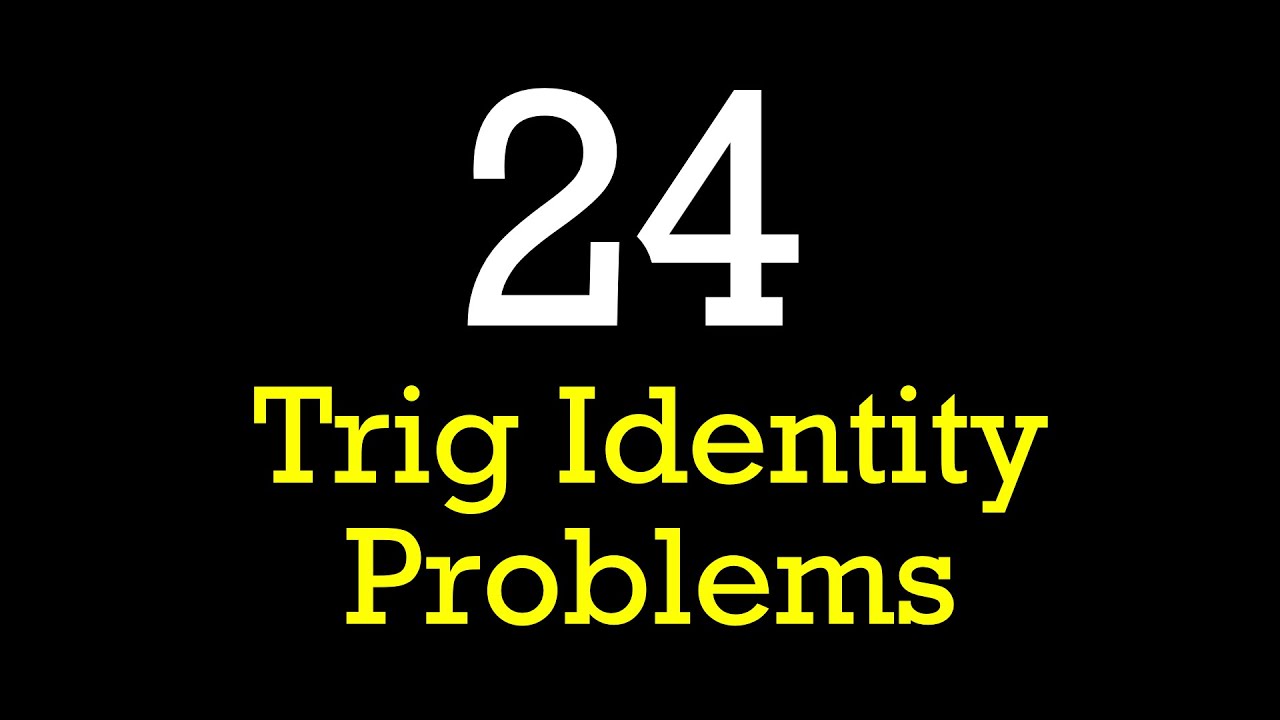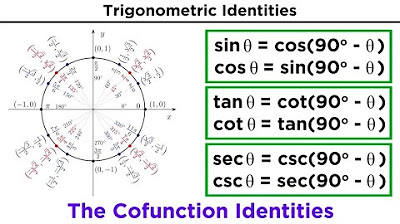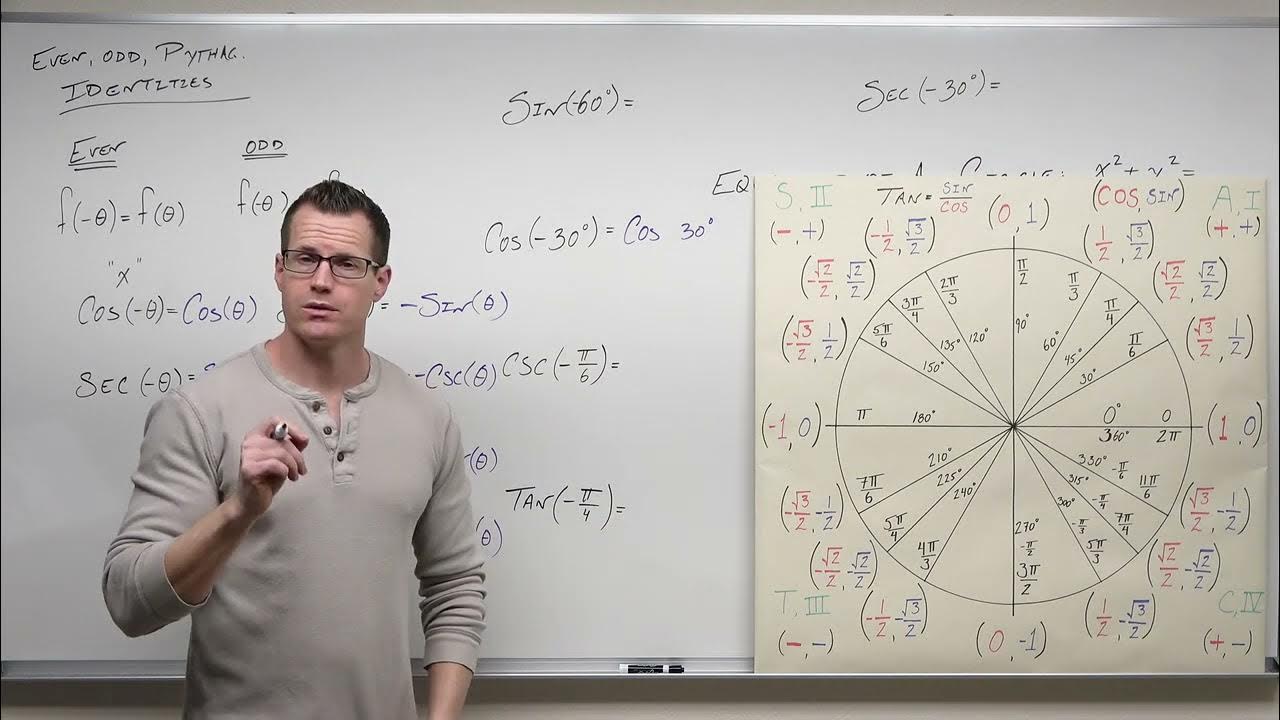Identities Grade 11: Introduction and practice
TLDRThis video script is an educational guide on trigonometric identities, specifically focusing on two key identities that are crucial for understanding in grade 11 mathematics. The first identity discussed is the Pythagorean trigonometric identity, which states that the sine squared plus the cosine squared of any angle equals one. The second identity is the definition of tangent, where sine of an angle divided by the cosine of the same angle equals the tangent of that angle. The script provides a step-by-step approach to solving various trigonometric expressions using these identities, emphasizing the importance of choosing the more complex side of the expression to simplify. It covers techniques such as finding a common denominator for fractions, multiplying numerators and denominators, and canceling out common terms. The video also touches on the concept of factorization to simplify expressions and the rearrangement of identities to suit different problems. Each step is carefully explained with examples, aiming to make the process clearer and easier for students to grasp. The script concludes with the resolution of several example problems, demonstrating the application of these concepts in practice.
Takeaways
- 📐 The Pythagorean identity states that sin²θ + cos²θ always equals 1, which is a fundamental concept in trigonometry.
- 🔢 The expression sinθ/cosθ simplifies to tanθ, which is a key relationship to remember when working with trigonometric functions.
- 🤔 When solving trigonometric identities, start with the more complex side of the equation and aim to simplify it to match the other side.
- 👉 When dividing fractions, keep the numerator the same and change the division sign to multiplication, then flip the second fraction.
- 📉 The process of simplifying involves reducing the number of terms in an expression, which often involves factorization and cancellation.
- 🧩 To combine fractions, find a common denominator, which allows you to add or subtract the fractions as a single term.
- ✅ Always verify your work by checking that the left-hand side of the equation equals the right-hand side after simplification.
- 🔁 Identities can often be rearranged to help simplify expressions, such as rearranging sin²θ + cos²θ = 1 to find cos²θ = 1 - sin²θ.
- 📌 Remember to work with the most complicated part of the expression first; this is often the side with the most terms or the least simplified form.
- 📙 It's important to practice and become comfortable with these identities, as they are frequently used in higher-level mathematics and physics.
- 📍 When faced with a complex expression, breaking it down into smaller, more manageable parts can make the simplification process easier.
Q & A
What is the first trigonometric identity mentioned in the video?
-The first identity is that sin^2(x) + cos^2(x) always equals 1, where x can be any angle.
What is the significance of the identity sin^2(x) + cos^2(x) = 1?
-This identity is fundamental in trigonometry and is used to simplify expressions involving sine and cosine of the same angle. It is also known as the Pythagorean identity.
What is the second main trigonometric identity discussed in the video?
-The second identity is that sin(θ)/cos(θ) equals tan(θ), which is useful for simplifying expressions involving the ratio of sine to cosine.
How does one approach simplifying an identity in trigonometry?
-To simplify an identity, one should choose one side of the expression that is more complex and work on transforming it into the other, simpler side.
What is the process of turning tan(θ) into sin(θ)/cos(θ) called?
-The process is not given a specific name in the video, but it involves expressing the tangent function in terms of sine and cosine, which is a standard trigonometric conversion.
How does one deal with fractions in trigonometric identities?
-When dealing with fractions, one should look for a common denominator to combine them into a single fraction, which simplifies the expression.
What is the role of the Pythagorean identity in simplifying trigonometric expressions?
-The Pythagorean identity (sin^2(x) + cos^2(x) = 1) is used to reduce the number of terms in an expression, making it simpler. It can be rearranged to solve for either sine or cosine squared.
Why is it important to remember the trigonometric identities mentioned in the video?
-These identities are crucial for solving various trigonometric problems and are often used in higher-level mathematics and physics. They are also not typically provided on formula sheets, so students are expected to memorize them.
How does one handle the multiplication of fractions in trigonometric identities?
-When multiplying fractions, you multiply the numerators together and the denominators together. This process is sometimes referred to as 'FOILing' when dealing with binomials.
What is the final step in proving an identity true?
-The final step is to show that the left-hand side of the identity is equal to the right-hand side, which confirms that the identity holds true.
What is the strategy for approaching the last example problem in the video?
-The strategy is to start with the right-hand side of the identity because it has two individual terms, which can be simplified and combined to match the left-hand side.
Why is it beneficial to reduce an expression with multiple terms to a single term?
-Reducing an expression to a single term simplifies the expression, making it easier to work with and understand. It also often leads to the discovery of hidden relationships or identities.
Outlines
📚 Introduction to Trigonometric Identities
The video begins with an introduction to trigonometric identities, emphasizing the importance of two key identities for grade 11 mathematics. The first identity is the Pythagorean identity, sin²θ + cos²θ = 1, which holds true for any angle θ. The second identity is the tangent identity, sinθ/cosθ = tanθ. The presenter advises memorizing these as they are not typically provided on formula sheets and are crucial for higher grade levels. The video then proceeds to demonstrate how to work with these identities through examples, starting with simplifying expressions and choosing the more complex side to work on.
🔍 Simplifying Trigonometric Expressions
This paragraph delves into the process of simplifying trigonometric expressions using the identities introduced earlier. It covers how to handle fractions within expressions and the technique of changing the 1/(sinθ/cosθ) into cosθ/sinθ to simplify further. The presenter also explains the common mistake students make when dealing with fractions and how to overcome it by treating the entire expression as a single fraction. The goal is to simplify the left side of the equation to match the right side using the identities and algebraic manipulation.
🧮 Advanced Simplification Techniques
The third paragraph focuses on advanced simplification techniques for trigonometric expressions. It discusses how to deal with fractions that are added or subtracted, requiring a common denominator for simplification. The presenter demonstrates the process of combining terms and simplifying them using the Pythagorean identity sin²θ + cos²θ = 1. The paragraph also highlights the importance of factorization in reducing multiple terms to a single term, which is a key strategy in simplifying trigonometric identities.
📝 Solving Complex Trigonometric Identities
The fourth paragraph continues with solving more complex trigonometric identities. It emphasizes the need to simplify each term individually before combining them, especially when dealing with fractions. The video illustrates how to manipulate terms involving cosθ and tanθ, and how to use the common denominator technique to combine them into a single fraction. The presenter also shows how to use the Pythagorean identity to further simplify the expression and eventually reach the desired simplified form.
🎓 Finalizing the Simplification Process
The final paragraph wraps up the video with a final question on trigonometric identities. It discusses the approach of starting with the right-hand side for simplification due to its structure with two individual terms. The presenter simplifies each term and then combines them using a common denominator of sinθ*cosθ. The paragraph concludes with the application of the Pythagorean identity to simplify the expression to 1/cosθ, matching the right-hand side of the original equation. The video ends with a confirmation that the left-hand side equals the right-hand side, thus proving the identity.
Mindmap
Keywords
💡Identities
💡Trigonometry
💡Pythagorean Identity
💡Tangent
💡Sine and Cosine
💡Simplifying Expressions
💡Common Denominator
💡
💡Factorization
💡Foil Method
💡Canceling Terms
💡Proving Identities
Highlights
The video discusses the importance of two main trigonometric identities for grade 11 students: sin^2(x) + cos^2(x) = 1 and sin(θ)/cos(θ) = tan(θ).
The identity sin^2(x) + cos^2(x) = 1 holds true for any angle x and is not typically provided on a formula sheet, so students need to memorize it.
The second identity, sin(θ)/cos(θ) = tan(θ), is crucial for simplifying trigonometric expressions and should be remembered for higher grades.
An identity in trigonometry is a way to transform one side of an expression into the other without treating it as an equation.
When working with identities, it's recommended to start with the more complicated side and aim to simplify it into a more straightforward form.
The video provides a step-by-step example of transforming tan(θ) into sin(θ)/cos(θ) and then simplifying the expression.
Students are shown how to handle fractions within fractions by converting them into a single fraction for easier manipulation.
The process of dividing fractions is demonstrated, emphasizing the need to flip the second fraction and multiply.
The video explains how to simplify the expression by combining terms over a common denominator and using the identity sin^2(θ) + cos^2(θ) = 1.
The concept of simplifying is emphasized as reducing the number of terms in an expression, which is often the goal when working with identities.
An example is worked through, starting with the left-hand side and simplifying each term before combining them.
The video demonstrates the use of the identity sin^2(x) + cos^2(x) = 1 to simplify the expression and achieve the desired result of 2/cos(x).
For the third example, the left-hand side is more complicated, and each term is individually addressed before combining them.
The process of finding a common denominator for fractions is shown, and the importance of not prematurely canceling out terms is emphasized.
The video concludes with a final example that involves rearranging the identity sin^2(θ) + cos^2(θ) = 1 to solve for cos^2(θ) and simplify the expression.
The final answer of the last example is derived by carefully factorizing terms and canceling out common factors.
The video concludes by reinforcing the method of proving that the left-hand side of a trigonometric identity is equal to the right-hand side through simplification.
Throughout the video, the presenter emphasizes the importance of practice and the repetitive nature of working with trigonometric identities.
Transcripts
Browse More Related Video

Verifying Trigonometric Identities

Pythagorean Identities - Examples & Practice Problems, Trigonometry

Ultimate trig identity problem study guide!

Basic Trigonometric Identities: Pythagorean Identities and Cofunction Identities

How do you simplify trigonometric expressions

Pythagorean Identities for Trigonometric Functions (Precalculus - Trigonometry 10)
5.0 / 5 (0 votes)
Thanks for rating: